Human-Altered Water and Carbon Cycles in the Lake Yangzong Basin since the Yuan Dynasty
Abstract
:1. Introduction
2. Materials and Methods
2.1. Study Area
2.2. Coring
2.3. Age Control
2.4. XRF Core Scanning
2.5. TOC Analysis
2.6. Numerical Analysis
3. Results
3.1. Lithology and Chronological Model
3.2. Correlation Analysis
3.3. Principal Component Analysis
4. Discussion
4.1. Indication of XRF Core Scanning Elements and PCA
4.2. The Indicative Significance of TOC
4.3. Human–Earth System Evolution in Lake Yangzong Basin during the Holocene
4.4. Transformation of Water and Carbon Cycle in the Lake Yangzong Basin since Yuan Dynasties
5. Conclusions
Author Contributions
Funding
Data Availability Statement
Acknowledgments
Conflicts of Interest
References
- Li, Q.; Wang, Y.; Li, L.; Zhang, H.; Wang, B. Ecological restoration scheme of lake basins on the karst plateau based on natural solution: Take nine lakes on the Yunnan Plateau as example. Carsologica Sin. 2023, 42, 391–401. [Google Scholar]
- Chen, F.H.; Chen, X.M.; Chen, J.H.; Zhou, A.F.; Wu, D.; Tang, L.Y.; Zhang, X.J.; Huang, X.Z.; Yu, J.Q. Holocene vegetation history, precipitation changes and Indian Summer Monsoon evolution documented from sediments of Xingyun Lake, south-west China. J. Quat. Sci. 2014, 29, 661–674. [Google Scholar] [CrossRef]
- Wang, M.; Meng, H.W.; Huang, L.P.; Sun, Q.F.; Sun, H.C.; Shen, C.M. Vegetation succession and forest fires over the past 13000 years in the catchment of Yangzonghai Lake, Yunnan. Quat. Sci. 2020, 40, 175–189. [Google Scholar]
- Li, H.J.; Chong, D.; Fan, S.; Zhang, S.Q.; Wang, J. Remote sensing monitoring of the nine plateau lakes’ surface area in Yunnan in recent thirty years. Resour. Environ. Yangtze Basin 2016, 25, 32–37. [Google Scholar]
- Li, J.L.; Li, H.Y.; Luo, L.C.; Gong, F.L.; Zhang, R.F.; Liu, F.L.; Wu, S.T.; Luo, B.Y. Water level retrieval for the past and prediction for the next 30 years at Lake Fuxian. Lake Sci. 2022, 34, 958–971. [Google Scholar]
- He, K.D.; Gao, W.; Duan, C.Q.; Zhu, Y.G.; Pan, Y.; Liu, C.E.; Zhang, W.; Yang, G.Y. Water level variation and its driving factors in Lake Dianchi, Fuxian and Yangzong during 1988–2015. Lake Sci. 2019, 31, 1379–1390. [Google Scholar]
- Hu, K.; Chen, G.J.; Huang, L.P.; Chen, X.L.; Liu, Y.Y.; Lu, H.B.; Tao, J.S.; Kang, W.G. Sediment records of extreme droughts and ecological consequences in Yuxian Lake, southeast Yunnan. Acta Hydrobiol. Sin. 2017, 41, 724–734. [Google Scholar]
- Liu, Q.; Chang, F.Q.; Xie, P.; Zhang, Y.; Duan, L.Z.; Li, H.Y.; Zhang, X.N.; Zhang, Y.; Li, D.L.; Zhang, H.C. Microbiota assembly patterns and diversity of nine plateau lakes in Yunnan, southwestern China. Chemosphere 2022, 314, 137700. [Google Scholar] [CrossRef] [PubMed]
- Crutzen, P.J. Geology of mankind. Nature 2002, 415, 23. [Google Scholar] [CrossRef] [PubMed]
- Li, Y.; Fang, L.C.; Wang, Y.Z.; Mi, W.J.; Ji, L.; Zhang, G.X.; Yang, P.H.; Chen, Z.B.; Bi, Y.H. Anthropogenic activities accelerated the evolution of river trophic status. J. Ecol. Indic. 2022, 136, 108584. [Google Scholar] [CrossRef]
- Zalasiewicz, J.; Waters, C.N.; Summerhayes, C.P.; Wolfe, A.P.; Barnosky, A.D.; Cearreta, A.; Crutzen, P.; Ellis, E.; Fairchild, I.J.; Gałuszka, A.; et al. The Working Group on the Anthropocene: Summary of evidence and interim recommendations. Anthropocene 2017, 19, 55–60. [Google Scholar] [CrossRef]
- Waters, C.N.; Williams, M.; Zalasiewicz, J.; Turner, S.D.; Barnosky, A.D.; Head, M.J.; Wing, S.L.; Wagreich, M.; Steffen, W.; Summerhayes, C.P.; et al. Epochs, events and episodes: Marking the geological impact of humans. Earth-Sci. Rev. 2022, 234, 104171. [Google Scholar] [CrossRef]
- Liu, Y.L.; Zhang, E.L.; Liu, E.F.; Wang, R.; Yuan, H.Z.; Kong, D.P.; Zhou, Q.C. TOC and Black Carbon records in sediment of Lake Yangzong, Yunnan Province under the influence of human activities during the past century. Lake Sci. 2017, 29, 1018–1028. [Google Scholar]
- Wang, R.; Zheng, W.X.; Xu, M.; Yang, H. The declines of heterogeneity and stability in diatom communities are associated with human activity. Ecol. Evol. 2023, 13, e10695. [Google Scholar] [CrossRef] [PubMed]
- Liao, L.Y.; Sun, Q.F.; Yu, M.M.; Meng, H.W.; Wang, M.; Chen, G.J.; Shen, C.M. Vegetation, climate and fires in the West Lake basin of Dali, Yunnan, China since the Industrial Revolution. Quat. Sci. 2024, 44, 174–190. [Google Scholar]
- Hillman, L.A.; Yao, A.; Abbott, B.M.; Bain, D.J. Two millennia of anthropogenic landscape modification and nutrient loading at Dian Lake, Yunnan Province, China. Holocene 2019, 29, 505–517. [Google Scholar] [CrossRef]
- Hillman, L.A.; Abbott, B.M.; Yu, J.Q. Climate and anthropogenic controls on the carbon cycle of Xingyun Lake, China. Palaeogeogr. Palaeoclimatol. Palaeoecol. 2018, 501, 70–81. [Google Scholar] [CrossRef]
- Li, K.; Liao, M.N.; Ni, J. Vegetation response to climate change and human activity in southwestern China since the Last Glacial Maximum. Palaeogeogr. Palaeoclimatol. Palaeoecol. 2024, 636, 111990. [Google Scholar] [CrossRef]
- Zhang, Y.; Liu, L.; Li, P.; Hu, Y.P.; Li, L.J.; Su, Y.W.; Xing, X.L.; Feng, J.; Ye, T. Changes of organic C and N stable isotope and their environmental implication during the past 130 years of Chen Lake. China Environ. Sci. 2023, 43, 1307–1316. [Google Scholar]
- Jin, Z.D.; Wang, S.M.; Shen, J.; Zhang, E.L.; Li, F.C.; Ji, J.F.; Lu, X.W. Chemical weathering since the Little Ice Age recorded in lake sediments: A high-resolution proxy of past climate. Earth Surf. Process. Landf. 2001, 26, 775. [Google Scholar] [CrossRef]
- Wang, S.M.; Zhang, Z.K. New progress of lake sediments and environmental changes research in China. Chin. Sci. Bull. 1999, 44, 579–587. [Google Scholar] [CrossRef]
- Wang, Y.B.; Xie, Y.; Liu, X.Q.; Shen, J.; Wang, Y.; Li, Z. Climate and human induced 2000-year vegetation diversity change in Yunnan, southwestern China. Holocene 2022, 32, 1327–1339. [Google Scholar] [CrossRef]
- Bonk, A.; Piotrowska, N.; Żarczyński, M.; Enters, D.; Makohonienko, M.; Rzodkiewicz, M.; Tylmann, W. Limnological responses to environmental changes during the last 3000 years revealed from a varved sequence of lake Lubińskie (western Poland). Catena 2023, 226, 107053. [Google Scholar] [CrossRef]
- Dionysios, S.; Alexandros, E.; Alessia, M.; Adam, L.; Pavlos, A. Holocene Hydroclimatic Changes in Northern Peloponnese (Greece) Inferred from the Multiproxy Record of Lake Lousoi. Water 2022, 14, 641. [Google Scholar]
- Sebastien, B.; Tjallingii, R.; Kylander, M.E.; Wilhelm, B.; Roberts, S.J.; Arnaud, F.; Brown, E.; Bindler, R. Inorganic geochemistry of lake sediments: A review of analytical techniques and guidelines for data interpretation. Earth-Sci. Rev. 2024, 249, 104639. [Google Scholar]
- Kylander, M.E.; Ampel, L.; Wohlfarth, B.; Veres, D. High-resolution X-ray fluorescence core scanning analysis of Les Echets (France) sedimentary sequence: New insights from chemical proxies. J. Quat. Sci. 2011, 26, 109–117. [Google Scholar] [CrossRef]
- Jansen, J.H.F.; Van der Gaast, S.J.; Koster, B.; Vaars, A.J. CORTEX, a shipboard XRF-scanner for element analyses in split sediment cores. Mar. Geol. 1998, 141, 143–153. [Google Scholar] [CrossRef]
- Francus, P.; Lamb, H.; Nakagawa, T.; Marshall, M.; Brown, E. The potential of high-resolution X-ray fluorescence core scanning: Applications in paleolimnology. PAGES News 2009, 17, 93–96. [Google Scholar] [CrossRef]
- Yang, H.E.; Zhao, Y.; Cui, Q.Y.; Ren, W.H.; Li, Q. Paleoclimatic indication of X-ray fluorescence core-scanned Rb/Sr ratios: A case study in the Zoige Basin in the eastern Tibetan Plateau. Sci. China Earth Sci. 2021, 64, 80–95. [Google Scholar] [CrossRef]
- Liang, Q.S.; Zhang, W.X.; Lin, Y.J.; Wu, M.J.; Liu, T.T.; Wang, L.M.; Ma, S.R. Study on elemental characteristics of lacustrine sediments and catchment erosion of Fuxian lake in central Yunnan plateau. China Environ. Sci. 2020, 40, 1740–1747. [Google Scholar]
- Sabatier, P.; Dezileau, L.; Colin, C.; Briqueu, L.; Bouchette, F.; Martinez, P.; Siani, G.; Raynal, O.; Grafenstein, U.V. 7000 years of paleostorm activity in the NW Mediterranean Sea in response to Holocene climate events. Quat. Res. 2012, 77, 1–11. [Google Scholar] [CrossRef]
- Li, D.; Tan, L.C.; Guo, F.; Cai, Y.J.; Sun, Y.B.; Xue, G.; Cheng, X.; Yan, H.; Cheng, H.; Edwards, L.R.; et al. Application of Avaatech X-ray fluorescence core-scanning in Sr/Ca analysis of speleothems. Sci. China Earth Sci. 2019, 62, 964–973. [Google Scholar] [CrossRef]
- Zhang, X.N.; Zhang, H.C.; Chang, F.Q.; Ashraf, U.; Peng, W.; Wu, H.; Liu, F.W.; Zhang, Y.; Duan, L.Z. Application of Corrected Methods for High-Resolution XRF Core Scanning Elements in Lake Sediments. Appl. Sci. 2020, 10, 8012. [Google Scholar] [CrossRef]
- Hu, N.J.; Shi, X.F.; Huang, P.; Liu, J.H. Distribution of metals in surface sediments of Liaodong Bay, Bohai Sea. China Environ. Sci. 2010, 30, 380–388. [Google Scholar]
- Lei, G.L.; Zhang, H.C.; Chang, F.Q.; Zhu, Y.; Li, C.H.; Xie, X.; Lei, Y.B.; Zhang, W.X.; Pu, Y. Comparison and correction of element measurements in lacustrine sediments using X-ray fluorescence core-scanning with ICP-OES method: A case study of Zigetang Co. Lake Sci. 2011, 23, 287–294. [Google Scholar]
- Niu, J.; Zhang, W.X.; Zhang, H.C.; Duan, L.Z.; Wu, M.J.; Wang, L.M. The characteristics of geochemical elements in Fuxian Lake sediments and its environmental significance based on XRF core scanning. Spectrosc. Spectr. Anal. 2019, 39, 2223–2227. [Google Scholar]
- Wu, Y.H.; Lücke, A.; Jin, Z.D.; Wang, S.M.; Schleser, H.G.; Battarbee, W.R.; Xia, W.L. Holocene climate development on the central Tibetan Plateau: A sedimentary record from Cuoe Lake. Palaeogeogr. Palaeoclimatol. Palaeoecol. 2006, 234, 328–340. [Google Scholar]
- Jin, Z.D.; Cao, J.J.; Wu, J.J.; Wang, S.M. A Rb/Sr record of catchment weathering response to Holocene climate change in Inner Mongolia. Earth Surf. Process. Landf. 2006, 31, 285–291. [Google Scholar] [CrossRef]
- Ma, X.Y.; Chen, D.; Yang, Y.P.; Zhang, Y.Z.; Zhang, J.W. Statistical Analysis of XRF Scanned Elements and Their Environmental Significance in Hala Lake, Qinghai, China. J. Salt Lake Res. 2014, 22, 1–10. [Google Scholar]
- Evans, G.; Augustinus, P.; Gadd, P.; Zawadzki, A.; Ditchfield, A. A multi-proxy μ-XRF inferred lake sediment record of environmental change spanning the last ca. 2230 years from Lake Kanono, Northland, New Zealand. Quat. Sci. Rev. 2019, 225, 106000. [Google Scholar] [CrossRef]
- Hardeng, J.; Bakke, J.; Cederstrøm, J.M.; Forsmo, J.; Haugen, T.A.; Sabatier, P.; Støren, E.W.N.; van der Bilt, W.G.M. A 7000-year record of extreme flood events reconstructed from a threshold lake in southern Norway. Quat. Sci. Rev. 2024, 331, 108659. [Google Scholar] [CrossRef]
- Rohozin, Y.; Ljung, K. Palaeoenvironmental changes in eastern Crimea over the last 7600 years inferred from a multi-proxy study of a sediment archive from Lake Chokrak. Holocene 2024, 34, 175–188. [Google Scholar] [CrossRef]
- Duxbury, L.C.; Johns-Mead, L.Y.; Cadd, H.; Francke, A.; Lӧhr, S.C.; Law, W.B.; Armbrecht, L.; Hall, P.A.; Zawadzki, A.; Jacobsen, G.E.; et al. Holocene climate and catchment change inferred from the geochemistry of Lashmars Lagoon, Kangaroo Island (Karti/Karta), southern Australia. Palaeogeogr. Palaeoclimatol. Palaeoecol. 2024, 634, 111928. [Google Scholar] [CrossRef]
- Wu, H.; Zhang, H.C.; Chang, F.Q.; Duan, L.Z.; Zhang, X.N.; Peng, W.; Liu, Q.; Zhang, Y.; Liu, F.W. Isotopic constraints on sources of organic matter and environmental change in Lake Yangzong, Southwest China. J. Asian Earth Sci. 2021, 217, 104845. [Google Scholar] [CrossRef]
- Yang, X.Y.; Ren, S.C. Structure model of karst underground water system in Yangzonghai basin, Yunnan. Yunnan Geol. 2024, 33, 103–107. [Google Scholar]
- Ming, Q.Z.; Tong, S.Y. Yunnan Geography; Beijing Normal University Press: Beijing, China, 2016; pp. 111–112. [Google Scholar]
- Zheng, W.X.; Wang, R.; Zhang, E.L.; Cao, Y.M.; Kong, D.P. Diversity and stability dynamic of chironomid assemblages in the last two centuries of Lake Yangzong, Yunnan Province. Lake Sci. 2018, 30, 847–856. [Google Scholar]
- Yu, M.M.; Meng, H.W.; Chen, J.L.; Sun, Q.F.; Shen, C.M. The radiocarbon reservoir effects of lakes in Yunnan. Quat. Sci. 2023, 43, 390–402. [Google Scholar]
- Reimer, P.J.; Bard, E.; Bayliss, A.; Beck, J.W.; Blackwell, P.G.; Ramsey, C.B.; Brown, D.M.; Buck, C.E.; Edwards, R.L.; Friedrich, M.; et al. Selection and Treatment of Data for Radiocarbon Calibration: An Update to the International Calibration (IntCal) Criteria. Radiocarbon 2013, 55, 1923–1945. [Google Scholar] [CrossRef]
- Yang, Y.P.; Ma, X.Y.; Wang, L.; Fu, X.; Zhang, Y.Z.; Zhang, J.W. Evaluation of three methods used in carbonate content determination for lacustrine sediments. Lake Sci. 2016, 28, 917–924. [Google Scholar]
- Qin, R.; Liu, L.Y.; Wang, J.J.; Liu, X.Q.; Zhang, Q.; Feng, S.N. Application of XRF core scanning in varved lake sediments: A case study on Lake Xinluhai in the southeastern margin of Qinghai-Tibetan Plateau. Lake Sci. 2022, 34, 1723–1734. [Google Scholar]
- Zhang, H.; Niu, L.L.; Yuan, Z.J.; Zhang, C.; Sun, H.L.; Zhang, X.J.; Zhou, A.F. Mid-late Holocene soil erosion record from lake deposit of Liupan Mountains. J. Earth Environ. 2021, 12, 146–158. [Google Scholar]
- Li, K.; Tan, B.; Ni, J.; Liao, M.N. Hydroclimate changes since Last Glacial Maximum: Geochemical evidence from Yilong Lake, southwestern China. Acta Ecol. Sin. 2018, 38, 8973–8982. [Google Scholar]
- Lan, M.W.; Song, Y.G.; Cheng, L.Q. Review on Formation of Lacustrine Carbonate Minerals and Their Paleoclimates Significance. J. Earth Sci. Environ. 2022, 44, 156–170. [Google Scholar]
- Jin, Y.; Wang, Y.; Hu, J.; Han, R.C.; Xiang, C.S. Geochemical Element Records and Hydrological Significance of Lake Shengjin Sediments During the Past Millennium. Acta Sedimentol. Sin. 2023, 41, 219–232. [Google Scholar]
- Li, W.C. Nitrogen accumulation in the sediment of East Taihu Lake and biological sedimentation of aquatic plants. China Environ. Sci. 1997, 17, 35–38. [Google Scholar]
- Pu, Y.; Han, Y.; Zhang, H.C.; Chang, F.Q. Late Holocene climatic and environmental variation in the source area of the Yellow River recorded by sediments from the Lake Ngoring, northeastern Qinghai-Tibetan Plateau. Quat. Sci. 2021, 41, 1000–1011. [Google Scholar]
- Lv, M.H.; Wang, H.Y.; Cai, Y.L.; Wang, W.B.; Xiu, L. Magnetic properties of core HF1-2 from Lake Hongfeng in Guizhou Province and its implications for soil erosion. Lake Sci. 2008, 20, 298–305. [Google Scholar]
- Song, Y.L.; Chen, J.A.; Yang, H.Q.; Ding, W.; Tao, H.B.; Luo, J.; Wang, J.F. Distribution and Source of the Organic Matter in the Sediment of Fuxian Lake, Yunnan Province. Bull. Mineral. Petrol. Geochem. 2016, 35, 618–624+607. [Google Scholar]
- Wu, J.; Shen, C.M.; Yang, H.; Qian, S.; Xie, S.C. Holocene temperature variability in China. Quat. Sci. Rev. 2023, 321, 108184. [Google Scholar] [CrossRef]
- Li, M.J.; He, F.N.; Yang, F.; Li, S.C. Re-construction of cropland area at the provincial level in the early Yuan Dynasty. Acta Geogr. Sin. 2018, 73, 832–842. [Google Scholar]
- Fang, T. The agriculture and agricultural taxes and levies of Yunnan province in the Yuan dynasty. J. Yunnan Norm. Univ. 2004, 4, 57–64. [Google Scholar]
- Gu, Y.J. The Immigration to Yunnan Province in the Dynasties of Yuan‚ Ming and Qing. Ethno-Natl. Stud. 2003, 2, 69–78+109. [Google Scholar]
- Li, T. Climate Change Since the 12 ka Recorded in the Sediments of Lake Fuxian. Master’s Thesis, Yunnan Normal University, Kunming, China, 2019. [Google Scholar]
- Yao, A.; Darré, V.; Jiang, Z.L.; Lam, W.C.; Yang, W. Bridging the time gap in the Bronze Age of Southeast Asia and Southwest China. Archaeol. Res. Asia 2020, 22, 100189. [Google Scholar] [CrossRef]
- Liu, P.L.; Liu, F.W.; Li, G.; Li, Y.J.; Cao, H.H.; Li, X.R. Anthropogenic Impact on the Terrestrial Environment in the Lake Dian Basin, Southwestern China during the Bronze Age and Ming-Qing period. Land 2024, 13, 228. [Google Scholar] [CrossRef]
- Martello, R.D. The origins of multi-cropping agriculture in Southwestern China: Archaeobotanical insights from third to frst millennium B.C. Yunnan. Asian Archaeol. 2022, 6, 65–85. [Google Scholar] [CrossRef] [PubMed]
- Gao, Y.; Dong, G.H.; Yang, X.Y.; Chen, F.H. A review on the spread of prehistoric agriculture from southern China to mainland southeast Asia. Sci. China Earth Sci. 2020, 63, 615–625. [Google Scholar] [CrossRef]
- Wei, W.J.; Gui, Z.F.; Xue, B.; Duan, H.T.; Yao, S.C.; Li, X.X. Effects of land use changes on the carbon storage of terrestrial ecosystem—A case study of Hulun Lake and Taihu Lake basins. Quat. Sci. 2012, 32, 327–336. [Google Scholar]
- Jiang, W.; Hou, Q.Y.; Yang, Z.F.; Xia, X.Q.; Zhong, C. Migration and Deposition Flux of Organic Carbon in the Wuyuerhe River Basin in Heilongjiang Province. Geoscience 2011, 25, 384–392. [Google Scholar]
- Gao, Y.; Luo, B.; Shen, D.; Jia, J.J.; Lu, Y.; Wang, S.Y. Recognition and challenges of the inland water carbon source and sink processes on the Qinghai-Tibet Plateau. Lake Sci. 2023, 35, 1853–1865. [Google Scholar]
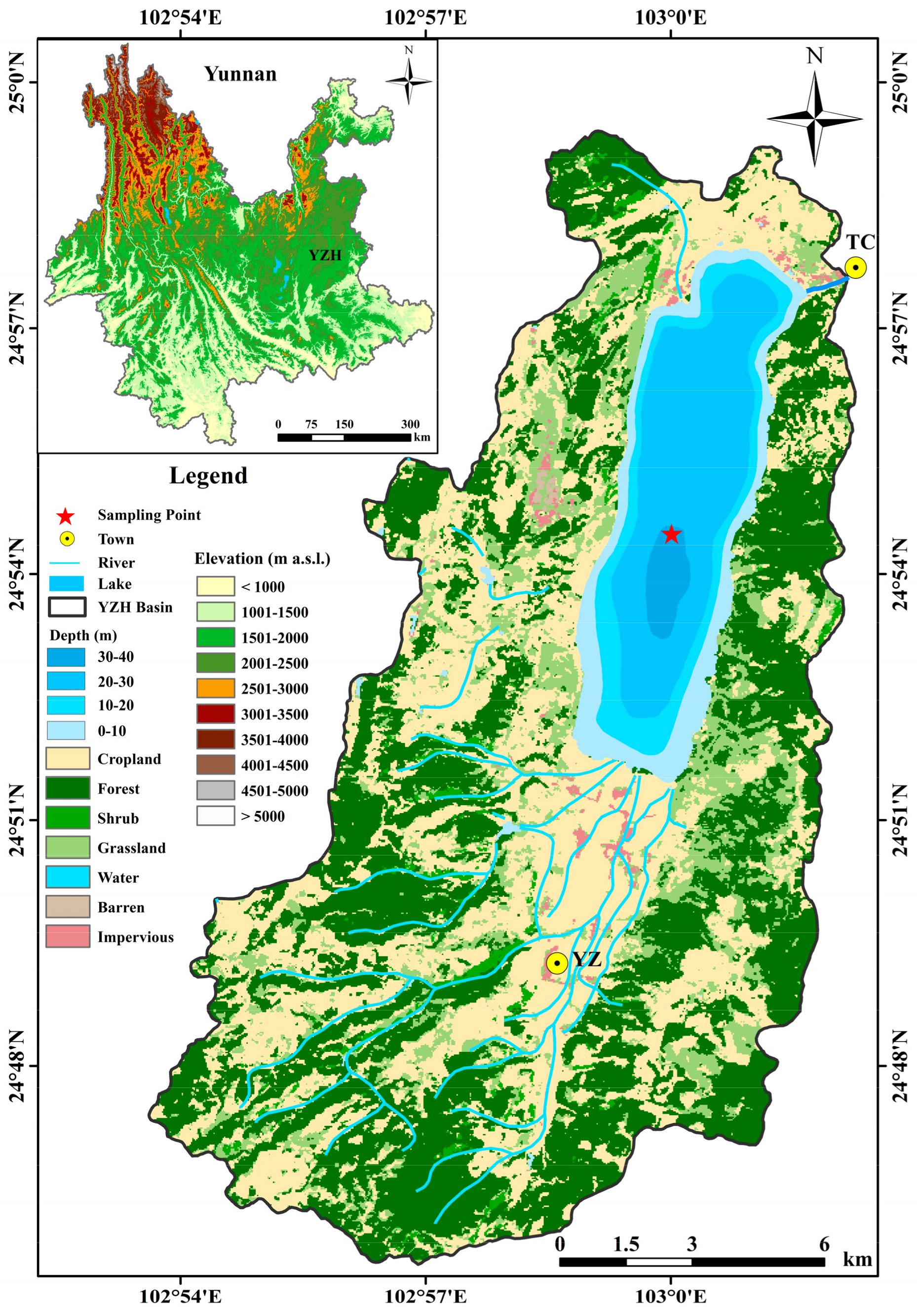
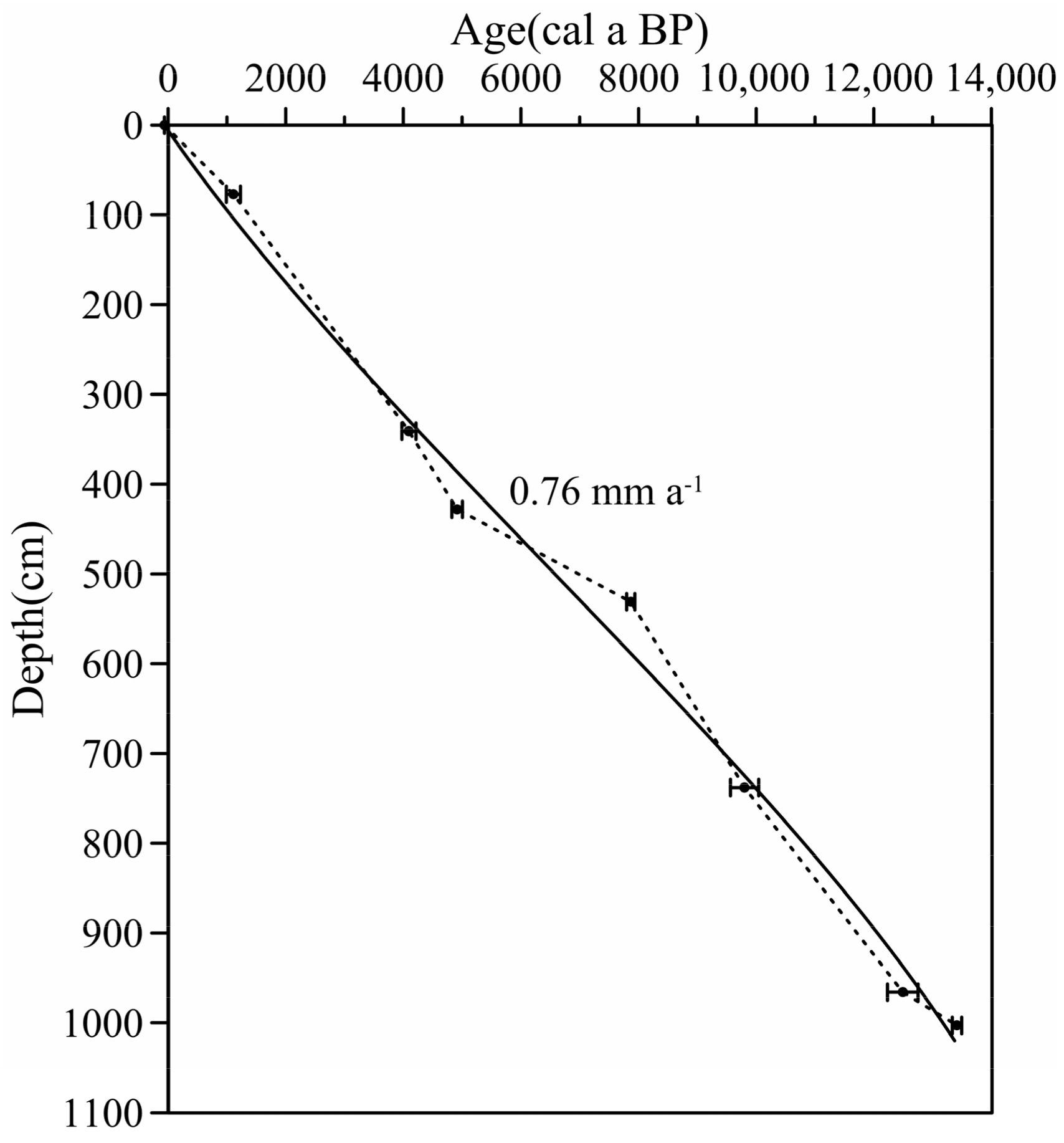
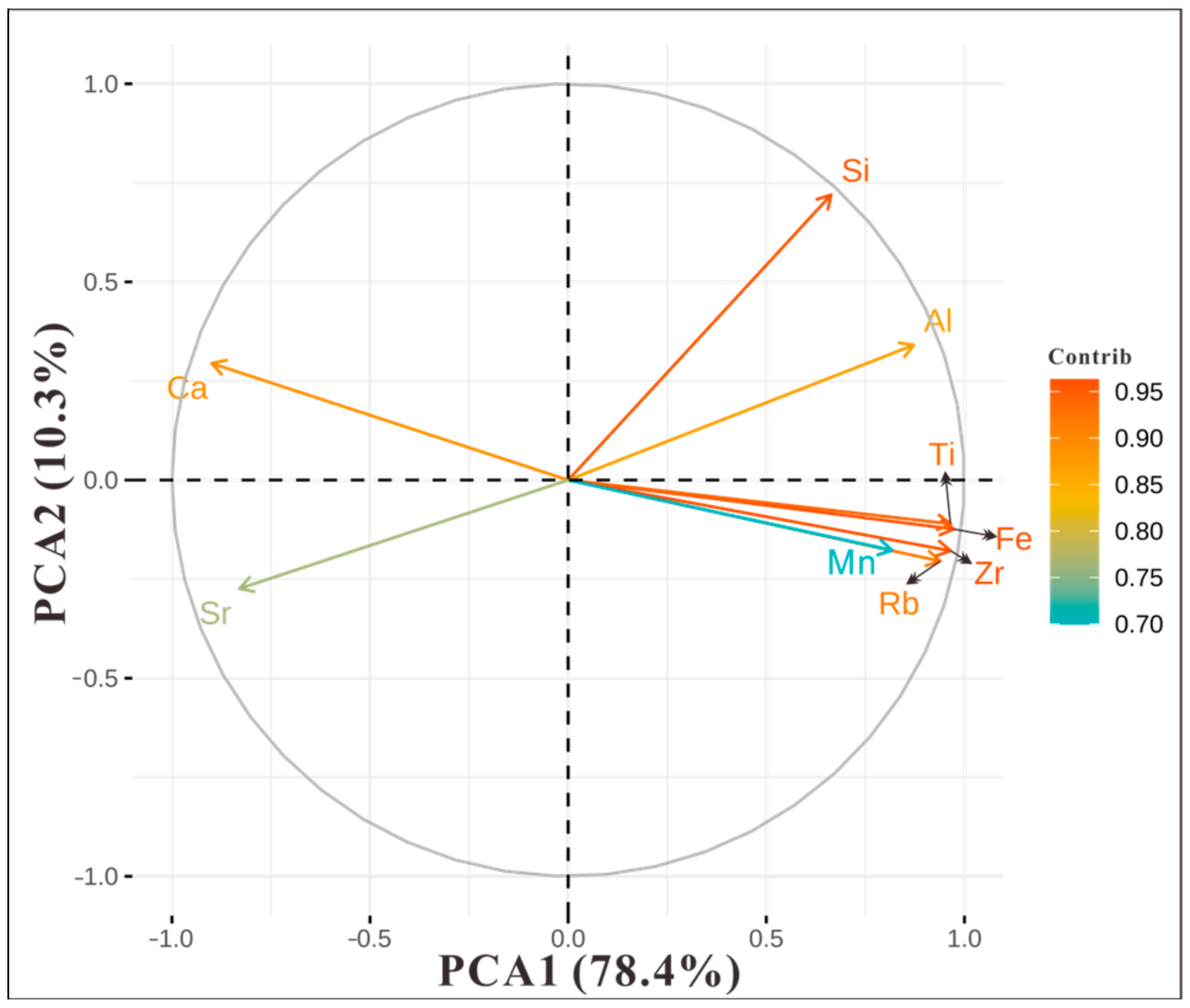
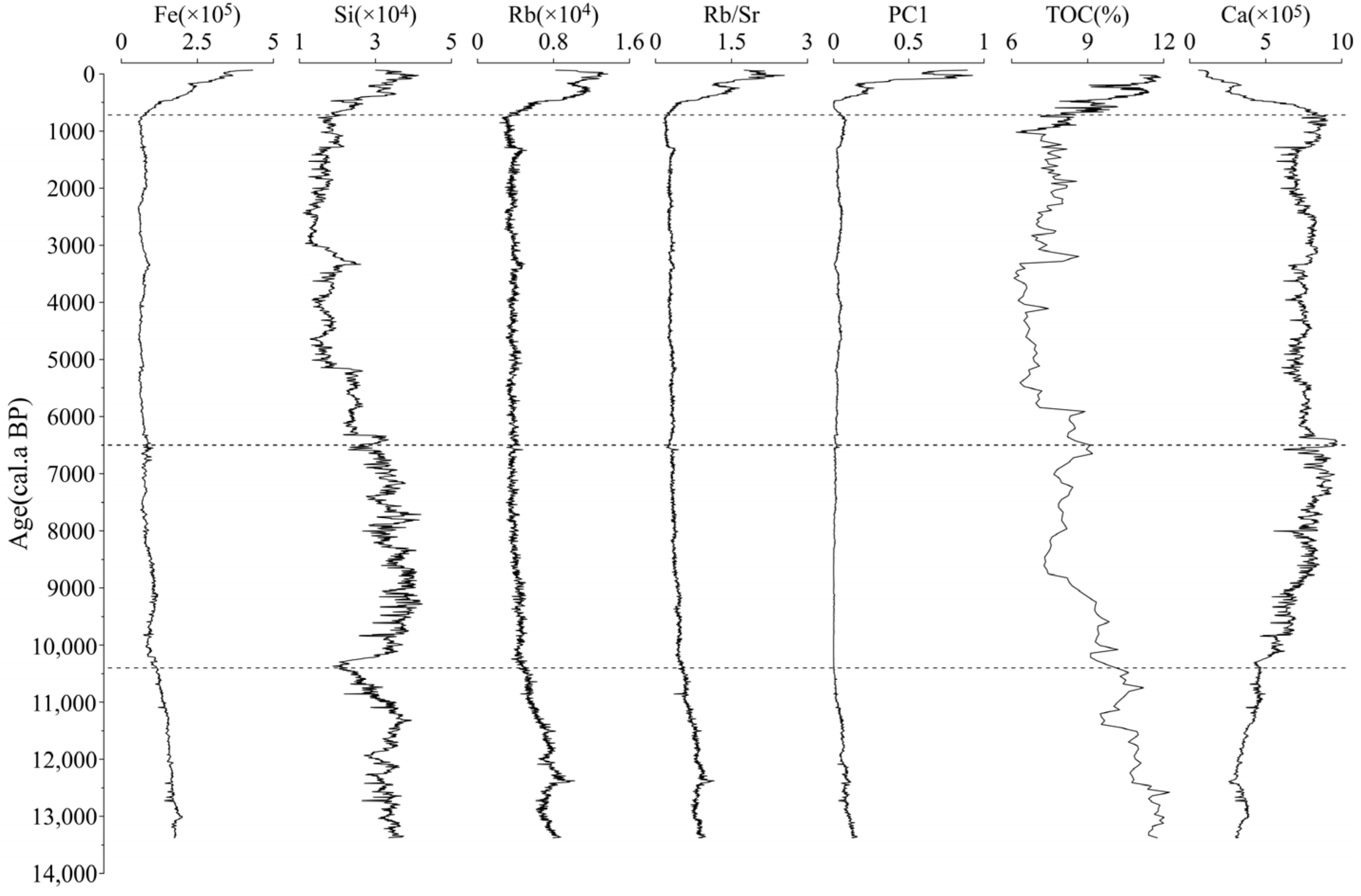
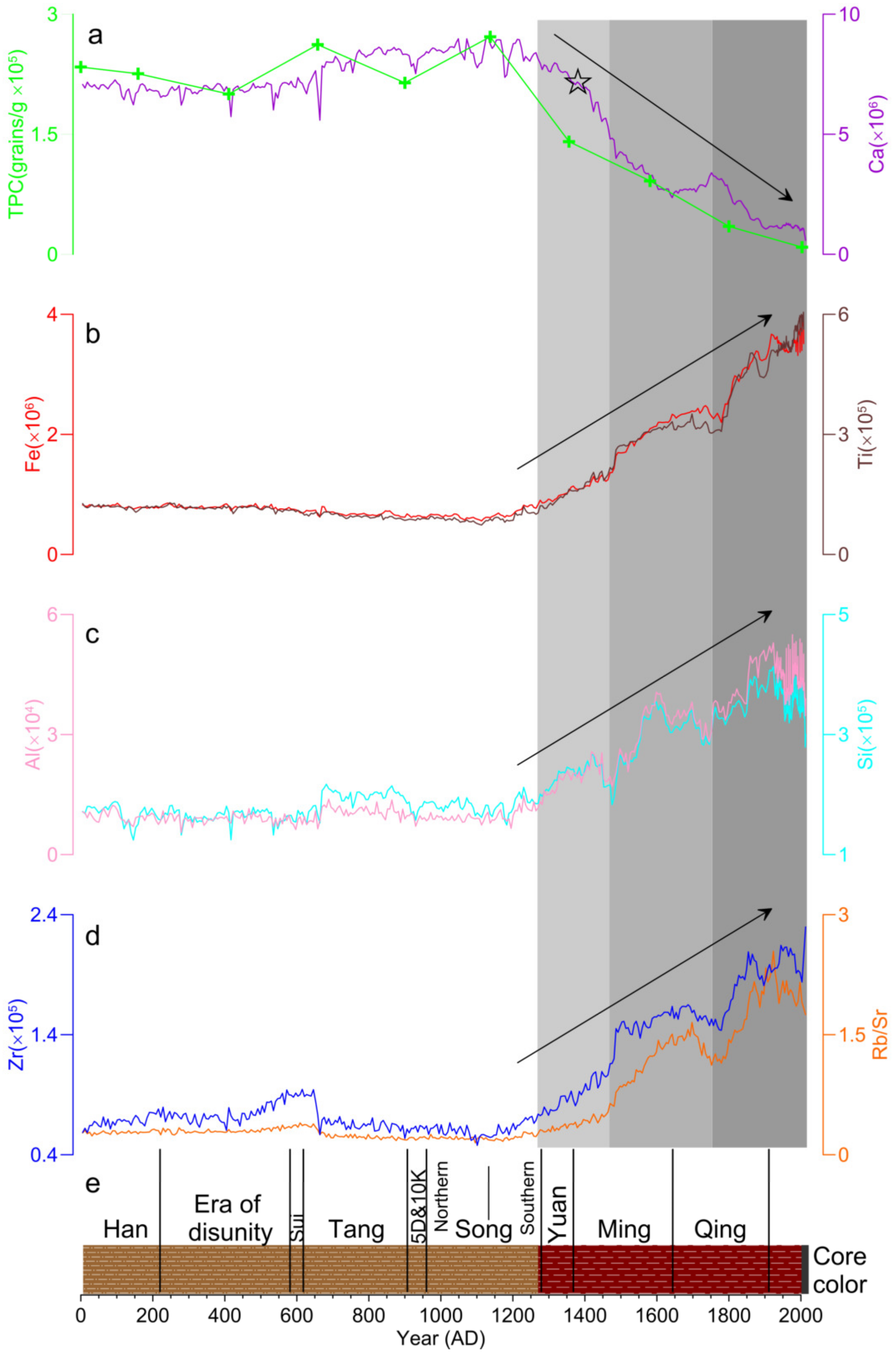
| Fe | Mn | Si | Al | Ca | Ti | Rb | Sr | Zr | |
|---|---|---|---|---|---|---|---|---|---|
| Fe | 1 | ||||||||
| Mn | 0.775 ** | 1 | |||||||
| Si | 0.486 ** | 0.177 ** | 1 | ||||||
| Al | 0.834 ** | 0.527 ** | 0.838 ** | 1 | |||||
| Ca | −0.870 ** | −0.681 ** | −0.140 ** | −0.567 ** | 1 | ||||
| Ti | 0.983 ** | 0.732 ** | 0.489 ** | 0.832 ** | −0.856 ** | 1 | |||
| Rb | 0.939 ** | 0.673 ** | 0.399 ** | 0.773 ** | −0.897 ** | 0.924 ** | 1 | ||
| Sr | −0.736 ** | −0.457 ** | −0.508 ** | −0.699 ** | 0.656 ** | −0.720 ** | −0.685 ** | 1 | |
| Zr | 0.955 ** | 0.715 ** | 0.380 ** | 0.761 ** | −0.905 ** | 0.957 ** | 0.968 ** | −0.663 ** | 1 |
Disclaimer/Publisher’s Note: The statements, opinions and data contained in all publications are solely those of the individual author(s) and contributor(s) and not of MDPI and/or the editor(s). MDPI and/or the editor(s) disclaim responsibility for any injury to people or property resulting from any ideas, methods, instructions or products referred to in the content. |
© 2024 by the authors. Licensee MDPI, Basel, Switzerland. This article is an open access article distributed under the terms and conditions of the Creative Commons Attribution (CC BY) license (https://creativecommons.org/licenses/by/4.0/).
Share and Cite
Li, H.; Jing, Y.; Zhang, H.; Shang, X.; Duan, L.; Li, H.; Li, D.; Li, Z. Human-Altered Water and Carbon Cycles in the Lake Yangzong Basin since the Yuan Dynasty. Water 2024, 16, 1271. https://doi.org/10.3390/w16091271
Li H, Jing Y, Zhang H, Shang X, Duan L, Li H, Li D, Li Z. Human-Altered Water and Carbon Cycles in the Lake Yangzong Basin since the Yuan Dynasty. Water. 2024; 16(9):1271. https://doi.org/10.3390/w16091271
Chicago/Turabian StyleLi, Huayong, Yuxue Jing, Hucai Zhang, Xuanxuan Shang, Lizeng Duan, Huayu Li, Donglin Li, and Zhuohan Li. 2024. "Human-Altered Water and Carbon Cycles in the Lake Yangzong Basin since the Yuan Dynasty" Water 16, no. 9: 1271. https://doi.org/10.3390/w16091271





